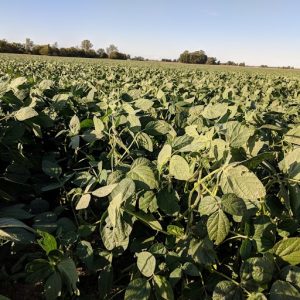Hazy days: How does light influence crop?
By Alexander Lindsey, Laura Lindsey, Aaron Wilson, Ohio State University Extension
Quite often this summer, our skies have been filled with smoke from western wildfires. Strong, dominant high pressure has focused record-breaking heat in the west while here across the Midwest, westerly to northwesterly flow has funneled that smoke our direction. Typically, this smoke remains at high altitude, resulting in hazy sunshine. What impact can this filtered sunshine have on crop production?
Capturing sunlight energy, which drives photosynthesis, is important to maximize crop yield. Typical plant canopy-level instantaneous light values (also known as photosynthetic photon flux density) on sunny days range from 1200 to 1800 µmol/m2/s while typical instantaneous plant canopy-level values for cloudy days are 100 to 400 µmol/m2/s. In general, sunny days (all else equal) are better for crops, especially if moisture is non-limiting.
For soybean, photosynthetic photon flux densities that exceed 700 µmol/m2/s produce minimal gains in leaf-level photosynthetic efficiency, which ultimately can translate into yield production. With radiation values above or below this level, the plant can still photosynthesize but may need to adjust leaf angle to change how direct interception is. As the sun moves across the sky, leaves can orient themselves perpendicular to incoming direct light to increase interception or parallel to the light to decrease direct interception as too much direct light can be harmful for plants. Changing orientation in the upper canopy can also allow for more light to be intercepted by lower leaves allowing for more leaves to optimize photosynthetic rates at a time.
Corn (having a slightly different photosynthetic pathway) can continue to increase photosynthesis with increasing light and tends to benefit from more sun if temperatures and water levels are not limiting growth. Upper leaves in corn grow more vertically and are smaller but become larger and more horizontal lower in the canopy. This orientation works to increase light penetration into the canopy and optimize interception. Corn’s major response to too much light (often paired with water stress or high vapor pressure deficit) is to roll its leaves to minimize excess light exposure.
So, with the wildfire haze and just regular cloudy days, how have our average radiation values for June and July compared to past years? In 2021, the daily average photosynthetic photon flux density was lower for June and July as compared to the last 4 years (2017-2020). Given these are daily values, the cumulative effects of this reduction will likely equate to lower overall yield potential because of the additive nature of light loss. However, cooler temperatures could help extend the season and help crops gain yield from more days with active growth during the grain fill period. The levels of light seen in 2021 may still be sufficient if other factors end up being more limiting to yield production; factors like water stress, biotic factors, and adequate mineral nutrition still play a major role in yield gains during the season.